Martello Towers in Kent
Martello Towers in Kent:
Hythe Towers Nos 10,11 & 12 no longer exist
![]() Hythe No.13
Hythe No.13
![]() Hythe No.14
Hythe No.14
![]() Hythe No.15
Hythe No.15
Hythe Towers 16,17 & 18 no longer exist
![]() Hythe No.19
Hythe No.19
Dymchurch Towers Nos. 20, 21 & 22 no longer exist
![]() Dymchurch No.23
Dymchurch No.23
![]() Dymchurch No.24
Dymchurch No.24
![]() Dymchurch No.25
Dymchurch No.25
St Mary's Bay Towers Nos 26 & 27 no longer exist

Martello Tower No.1 Folkestone
Martello Tower No. 1 stands on the cliffs 200 feet above East Wear Bay north of Folkestone town. It was the first of a line of towers along the Kent and Sussex coasts, it was built in 1805-06 in response to the threat of invasion by France during the Napoleonic wars.
Built of brick, its plan is externally slightly elliptical, with sides sloping inwards towards the top, but internally circular, with a massive central column. Martello tower walls generally vary in thickness around the circumference, with thicker walls facing the sea.
It was converted for residential use in 2015.
The exterior has been refaced with brick, with windows at first floor level, and door and windows inserted at ground floor level. Another floor is being added to the top of the tower: the circular breeze block wall, faced with brick, rises about 2m above the top of the tower.
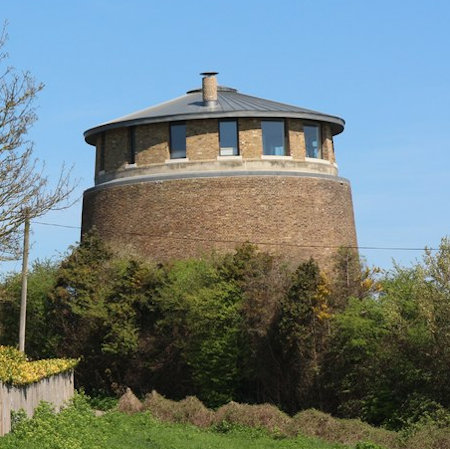
Martello Tower No.1 in 2018
The new roof rests on a structure of steel girders supported on steel uprights set into the wall, which slope gently down from a central apex. The tower wall is regularly pierced by windows all around, which are narrower on the landward side of the tower, and wider on the seaward side because of its elliptical plan.
The tower would originally have been entered at first-floor level via a retractable ladder, where the original door opening survives, but access is now through the ground floor.
All interior walls are brick, as is the massive central column (constrained on the first floor by seven steel bands). The ground floor space has been subdivided as part of the residential conversion.
Martello Tower No. 2 Folkestone
Martello Tower No.2 is located in Wear Bay Road in Folkestone. Built in 1806, it is privately owned and has been converted into a home for holiday lettings.
Martello Tower No. 2 is about 50 feet lower than No. 1, and sited on a small knoll slightly further inland, where Wear Bay Road is now situated. The tower was converted into a house with a full roof, similar to that on Martello Tower No. 8.
Extra windows have been added and the exterior coated with a coloured lime rendering. Surrounded by tall trees and situated up a private track, the tower is really only visible from a high position.
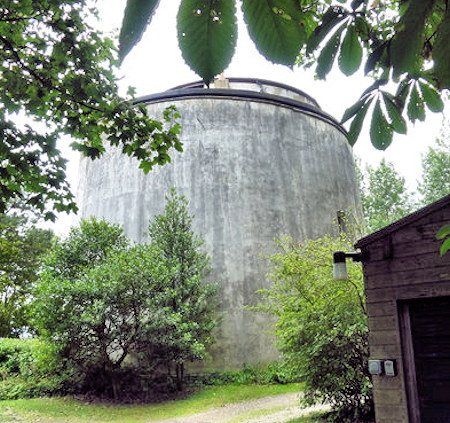
Martello Tower No.2
It has brick walls, which have been rendered and tapering inwards as they rise. It still has its original first-floor door on SW converted to a window, with its entrance now at the ground floor on the east.
Two original first-floor openings also retained on SW close to the original doorway, but with C20 windows inserted.
There are four other windows also closely spaced on this side of the tower. The interior retains its centre brick pier and brick vaulting at first and ground floors. There is a magazine on the east on the ground floor.
Martello Tower No.3 Folkestone
Martello Tower No. 3 was constructed in 1806 on the cliff edge at Folkestone above Copt Point. It was used as a Visitor centre up to 2011 but since then has laid idle with its condition deteriorating.
After 1850 the tower was used by the Coastguard, with the Coastguard members and families living there. During WWII the tower had a concrete observation point added on the roof, incorporating the tower with the coastal battery built adjacent to the tower.
A few years later another platform was added to the top of the tower although it was later removed. The tower was disused after the war until 1990 when Shepway Council bought it and later opened it as a visitor centre, now closed. It is currently leased to the Creative Foundation, who hope to undertake repairs to the tower.
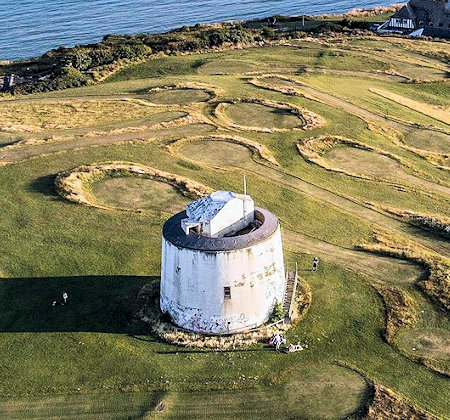
Martello Tower No.3 2021
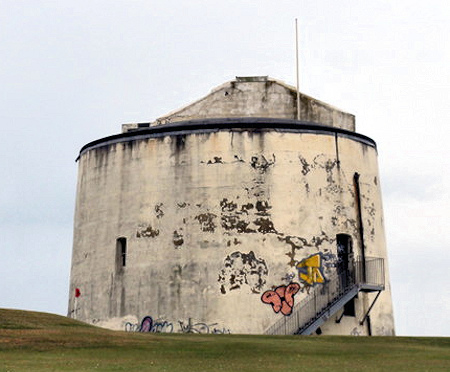
Martello Tower No.3
Martello Tower No.4 Folkestone
This Martello Tower is located The tower is situated on Radnor Cliff in a private garden at the end of 'The Leas' in Folkestone and overlooks a residential area below and the coastline beyond.
The tower is set within a dry moat and with an outer glacis (sloping bank), and supporting the remains of a later, World War II observation post.
The tower survives well despite some later alterations and retains a substantial proportion of its original components and associated features, including the glacis bank.
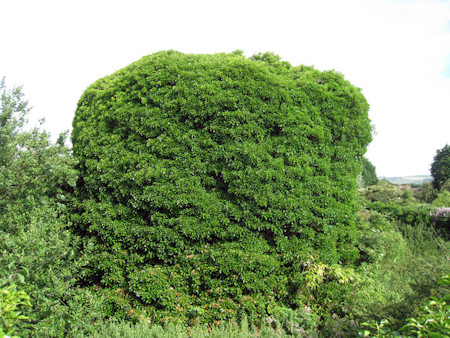
Martello Tower No.4
When viewed as one of a series of six clifftop towers, Tower No. 4 illustrates the strategically planned integration of the martello tower system.
The construction of an observation post on the roof of the tower during WW II, demonstrates the continued significance of this location and provides an insight into the role of coastal defence during the 19th and early 20th centuries.
It is completely overgrown with ivy, the brickwork cannot even be seen. It was once used as a Semaphore station.
 Historic England Listing
Historic England Listing
Historic England At Risk Register Entry October 2020
Martello Tower No.5 Folkestone
A very good example of a Martello tower, set within a dry moat and outer glacis (sloping bank). It is located immediately west of the Folkestone School for Girls in the south-west part of Folkestone.
It is one of a clifftop series of six moated towers, constructed in 1805-6 to defend the coastline between Hythe and Folkestone, and lies around 400m north-west of Tower no 4.
The external face of the tower was rendered in a cement mortar, or stucco, which served to strengthen the outer skin of bricks. The stucco covering appears to be in good condition and the inland location of the Martello Tower has meant that coastal erosion and weathering has not affected it.
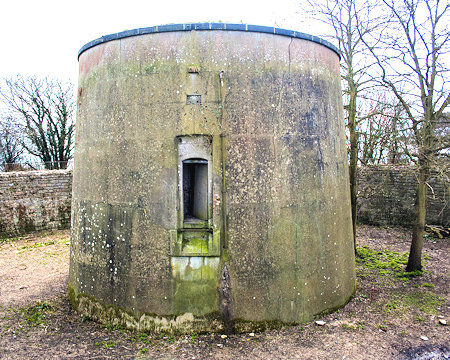
Martello Tower No.5
As part of the original design, soil was built up against the outer face of the moat wall to form a glacis, which slopes away from the lip of the moat for a distance of up to 20m.
Access into the tower is by way of a first-floor doorway, which was originally approached by a drawbridge across the moat, capable of being raised to seal the entrance. The bridge no longer survives, although the wheels of the drawbridge mechanism remain in place.
The tower has the potential for re-use by the school. The preservation of archaeological and historical significance will be the main consideration in assessing the suitability of proposals to convert Martello towers for residential use.
 Historic England Listing
Historic England Listing
Historic England At Risk Register Entry October 2020
This Martello Tower is located close to Shorncliffe Camp. It is in a deep, heavily overgrown moat and is currently empty. It is located above a steep, south facing slope, overlooking Sandgate and the sea beyond.
Built in 1806, the tower is one of a clifftop series of six moated towers, constructed in 1805-6 to defend the coastline between Hythe and Folkestone, and lies around 360m north east of Tower no 7.
The external face of the tower was rendered in a cement mortar, or stucco, which served to strengthen the outer skin of bricks, and traces of this survive.
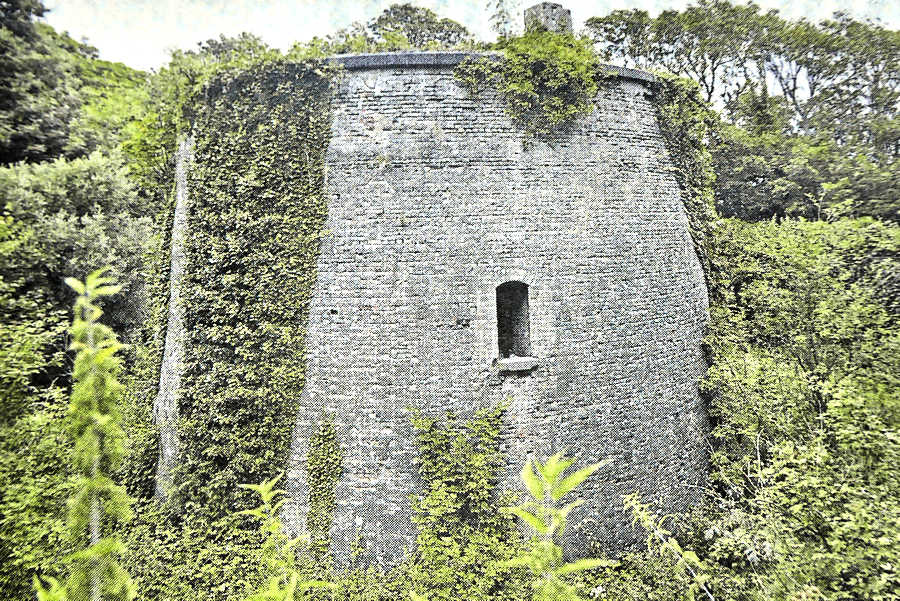
Martello Tower No.6
Access into the tower is by way of a first-floor doorway to the north, which was originally approached by a footbridge which spanned the moat.
The section nearest the tower was designed as a drawbridge, capable of being raised to seal the entrance. The bridge does not survive, although part of the mechanism used to raise it remains in place.
The tower is now owned privately, and the owner is seeking planning permission for the tower to become a holiday home. The same person owns Tower No.7.
 Historic England Listing
Historic England Listing
Historic England At Risk Register Entry October 2020
Now privately owned this 16th Century castle was updated with a Martello Martello Tower in 1805 but does not form part of the numbered sequence of Martello Towers. It is in line with Martello Tower 5, which is located on much higher ground.
The Castle is an artillery fort originally constructed by Henry VIII between 1539 and 1540, as part of the same series of defences as Sandown, Deal and Walmer Castles, but altered again for defence purposes in 1805.
It comprised a central stone keep, with three towers and a gatehouse. It could hold four tiers of artillery and was fitted with a total of 142 firing points for cannon and handguns.
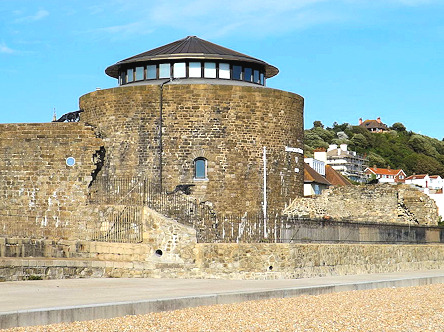
Sandgate Castle
The keep was turned into a Martello tower; when the work was completed, it was armed with ten 24-pounder (11 kg) guns and could hold a garrison of 40 men.
The castle had begun to suffer damage from the sea by the early 17th century, and by the middle of the 19th century, the receding coastline had reached the edge of the castle walls.
The high costs of repair contributed to the government's decision to sell the site off in 1888. It was initially bought by a railway company and then passed into private ownership.
Martello tower no 7 survives well, and retains many of its original components and associated features, such as a section of its glacis bank and part of its drawbridge mechanism. When viewed as one of a series of six cliff top towers,
Tower No7 illustrates the strategically planned integration of the martello tower system and provides a valuable insight into the defence of Britain during the early 19th century.
This Martello Tower is located close to Martello Tower 6 and is in a similar state. There is no access to either Martello Tower due to the depth of the ditch.
The external face of the tower was rendered in a cement mortar, or stucco, which served to strengthen the outer skin of bricks, and traces of this survive.
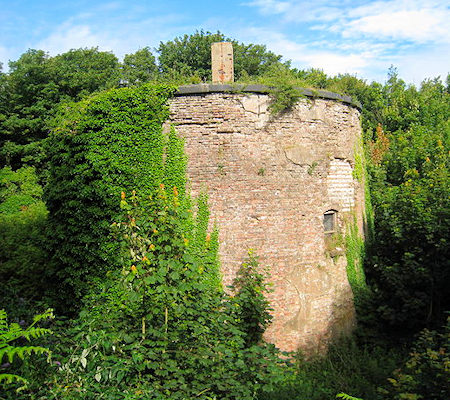
Martello Tower No.7
A thick central column rises from the basement to the top of the tower, from which springs the barrel-vaulted first-floor ceiling which supports the gun platform on the roof.
Access into the tower was by way of a first-floor doorway to the north, which was originally approached by a footbridge which spanned the moat. The section nearest the tower was designed as a drawbridge, capable of being raised to seal the entrance.
The bridge does not survive, although part of the mechanism used to raise it remains in place within the tower.
 Historic England Listing
Historic England Listing
Historic England At Risk Register Entry October 2020
This Martello Tower is a private residence and the moat has been turned into a garden.
The tower is located above a steep, south facing slope, overlooking Sandgate and the sea beyond.
The tower was built in l806 as part of the coast defences. Circular tower built of brick with walls 51/2 ft to 6 ft thick. In the centre is a brick pillar with vaulted arches springing from it.
On the ground floor was the magazine and above it quarters for the garrison divided into 2 rooms with a gun emplacement on the roof. Ditch with ramparts lined with ashlar.
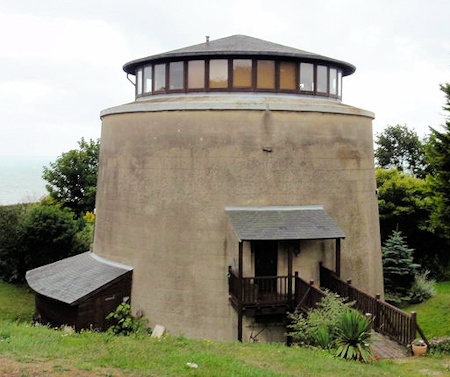
Martello Tower No.8
The ditch has been filled up on the north side. The original door was about 2 ft above the ground.
 Historic England Listing
Historic England Listing
This Martello Tower proved to be the most difficult to find, being located at the edge of a large wooded area above Seabrook. The Martello Tower's doors are sealed, but there seems to have been recent work on clearing the ditch, and the Martello Tower is largely free from ivy. The stones around the parapet have fallen into the ditch, but around half the stucco covering remains.
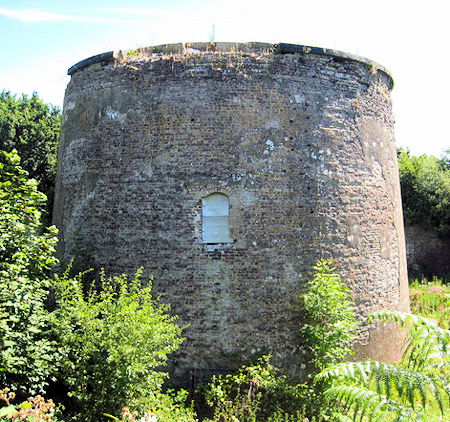
Martello Tower No.9
Martello Towers Nos 10, 11 & 12 In Hythe are no longer standing.
This Martello Tower has been converted into a private residence, but in a very different style to most conversions and it has been altered so much that the shape is the only recognisable feature.
Martello Tower No. 13 is located in Western Parade, in Hythe, a residential street lined with houses along the seafront at Hythe. It blends in with the other houses as it too is now a private residence. The tower is the usual design with added windows and roof access and is white-washed. It commands great views across the sea and is appropriately named.
Martello No. 13 was sold to a builder in 1928, who undertook repairs and renovations and converted it into a residence. It was sold again in 1938 and used as an observation post in the Second World War.
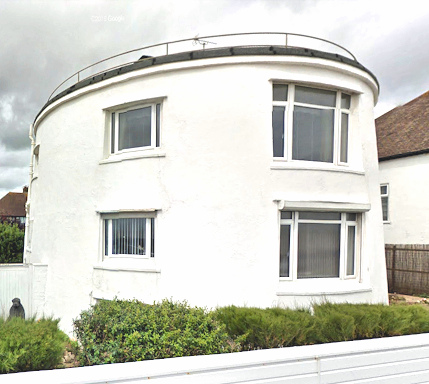
Martello Tower No.13
Further renovations and modernisation were carried out in the 1960s; new large windows were added and the walls were made thinner by the removal of the internal layer of brickwork in order to increase the floor space.
At the same time, a new room was added to the roof. The tower has remained as a private residence ever since.
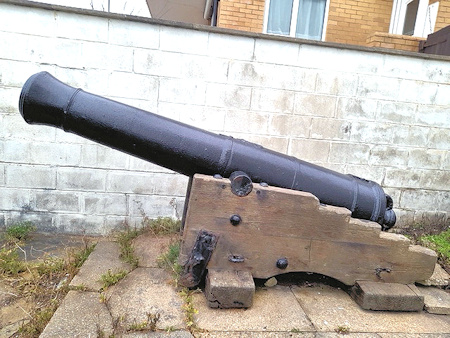 Cannon at Martello Tower No.13 2021
Cannon at Martello Tower No.13 2021
Martello Tower No.14 is one of a surviving pair (Tower No.15) situated on the beach at the eastern end of the Hythe Army Ranges. The tower lies 320m north east of tower Tower No.15 and was constructed in 1805-6 as part of a chain of 11 regularly spaced towers guarding the coastline from Hythe to Dymchurch.
Martello Tower No.14 survives well, and retains many of its original components.
As one of the few surviving examples of a chain of original towers, Tower No.44 illustrates the strategic distribution of towers at vulnerable points of the coastline and demonstrates the integration of the martello tower system in the defence of Britain during the early 19th century.

Martello Tower No.14
The door was reached from the ground by a retractable ladder, although this has not survived. The doorway is headed by a stone plaque which displays the tower number.
The sandbank of an adjacent firing range abuts the north western wall of the tower, burying part of the wall below the door.
NB The tower can only be viewed at low tide and when there is no firing on the ranges.
This Martello Tower is close to Tower No.14 on Hythe Army Ranges, it is empty and bricked up.
In November 2018 repair and maintenance were undertaken, to keep the tower in reasonable condition. The entrance to the tower, some 20 ft above the ground, has been bricked up and louvre type windows added to help with ventilation and to keep birds out.
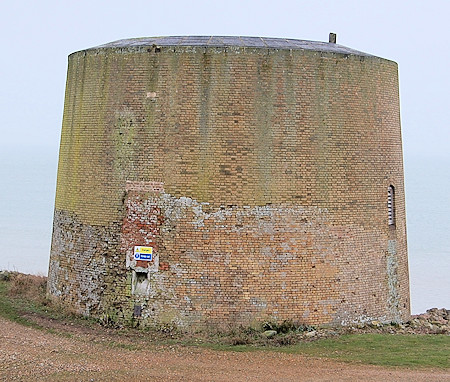
Martello Tower No.15
The next few Martello Towers in line with this one have been eroded by the sea.
NB The tower can only be viewed at low tide and when there is no firing on the ranges.
Martello Towers Nos 16, 17 & 18 on Hythe Ranges are no longer standing, having been lost to the weather and sea erosion..
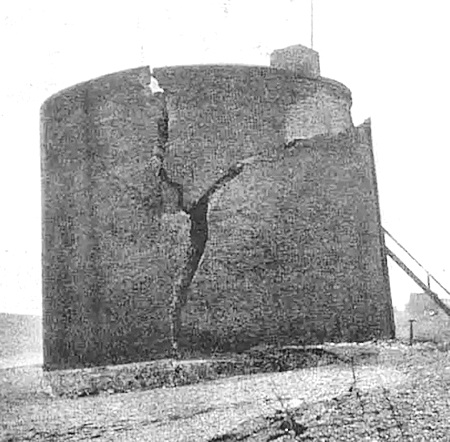
Martello Tower No.17 starting to collapse in c1899
before it disappeared completely
Martello Tower No.19 is located right on the beach to the east of the Hythe Army Ranges.
It was built in 1806 but in late 1970 it was undermined by the sea. In the 1960s it was still in reasonable condition and was listed in 1973.
The tower has now (2019) collapsed on the shingle beach, having been slowly worn away by the incoming tide. The tower is still recognisable for what it was, providing an insight in the fabric of the tower eg the thickness of the walls can be seen, smoke holes etc
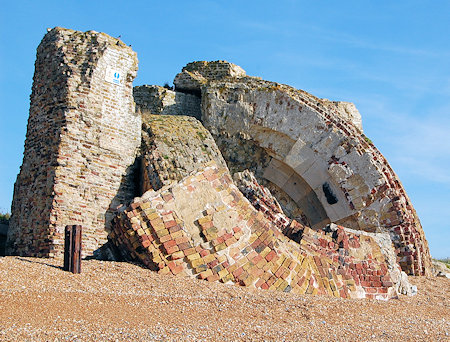
Martello Tower No.19 in 2018
NB The tower can only be viewed at low tide and when there is no firing on the ranges.
Martello Towers Nos 20, 21 & 22 in Hythe and Dymchurch are no longer standing.
Martello Tower No.23 Dymchurch
This Martello Tower is located on the A259 coast road just outside Dymchurch village. The tower has been restored and converted into a private dwelling in the standard style.
Martello Tower No. 23 was built to protect the Willop Sluice, one of the main sluices helping to drain Romney Marsh. It was paired with Martello Tower No. 22 to the north on the other side of the sluice. Tower No.22 has since been demolished to make way for road widening.
Originally the ground floor was where the magazine store was located and the first and second floors were the living quarters.
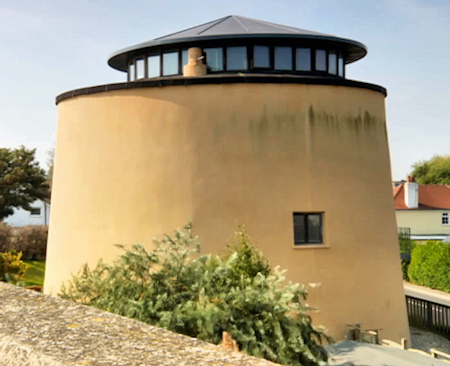
Martello Tower No.23
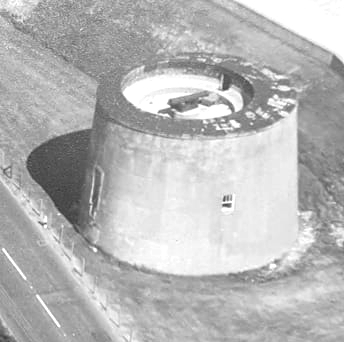 Tower No. 23 has been converted into a home
Tower No. 23 has been converted into a home
with windows on the top to take advantage of
the sea views.
Martello Tower No.23 Before Renovations ►
It featured on the television series called World's Most Extreme Homes and can be seen on ![]() this YouTube clip.
this YouTube clip.
Martello Tower No.24 Dymchurch
Of the 74 Martello Towers built on the Kent and Sussex coast, Martello Tower No.24 is considered to be the best surviving example, being closest to its original condition and it can be seen as it was when occupied by the military in 1806.
It has been restored to its original design and layout with almost all of the original tower still in place, including brickwork, front and parapet doors, window openings, fireplaces, ventilation shafts, the original 24 pounder muzzle-loading cannon on the gun platform, parapet shot lockers, hauling rings, replica gunpowder barrels, and replica 'Brown Bess' muskets.
Martello Tower No. 24 was built as one of a pair (Martello Tower No.25 to the south) to protect the Marshland Sluice, one of the main sluices helping to drain Romney Marsh.
From about 1819/20, Martello Tower No.24 was taken over by the newly formed Royal Naval Coast Blockade Service in the 'war' against smuggling on Romney Marsh.
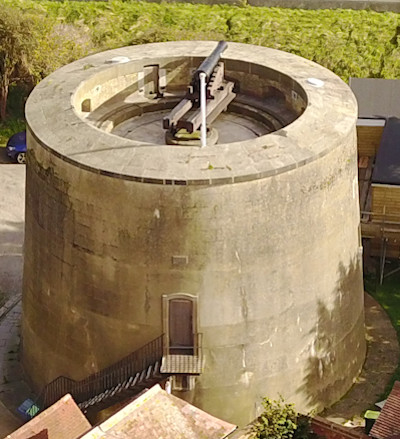
Martello Tower No.24
In 1831 the Coast Blockade was absorbed into The Coastguard Service, which came into operation in 1822 and the Coastguard continued to use the tower, together with their families. During the Second World War, it was used to spot incoming aircraft and the V1 & V2 flying bombs.
The tower is owned by English Heritage, with The Friends of Martello24, a Registered Charity, acting as custodians of the tower on their behalf and who manage its openings to the public, both on a regular basis and bespoke visits.
Please visit www.martello24.net for more information
Martello Tower No. 25 Dymchurch
Martello Tower No.25 is located in the Dymchurch Martello car park just as you enter Dymchurch on the A259 from New Romney to its south.
Martello Tower No. 25 was built as one of a pair (Martello Tower No.24 to the north) to protect the Marshland Sluice, one of the main sluices helping to drain Romney Marsh.
The outside of the tower has been restored but the inside is in a poor condition. It is currently unused and closed up.
![]() See inside
See inside

Martello Tower No.25
The tower was for a time in private ownership and then given to the District Council. It wasn't in a good state of repair and at some time in the early 1970s the District Council had the outside rendered. For a short time it was used as a cafe. In 2017 it was sold at auction to a private buyer, who have since received planning permission (May 2019) to convert the tower into a four-storey 4 bedroomed holiday let. As at January 2020, the conversion work has not yet started
Martello Towers Nos 26 and 27 were the first brick-built structures to appear on the St. Mary's Bay shoreline. Tower 26 was built on the eastern side of the Globsden Gut Sluice, which ran into the sea near the present Dunstall Lane. Tower No. 27 was built approximately a quarter of a mile to the west; both were built to protect the Globsden Gut Sluice.
Neither tower stands today. Damaged by sea erosion, No. 27 was demolished in 1841 and No. 26 lasted until 1871. The site of Tower 26 was on what is now the sea wall next to the car park opposite Dunstall Lane, roughly in front of where the toilet block now stands.


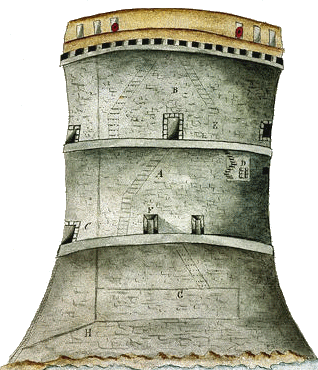


 Red Dragon I.T. Ltd.
Red Dragon I.T. Ltd.